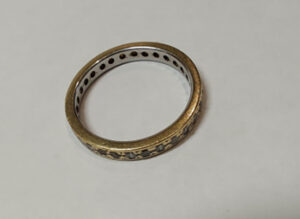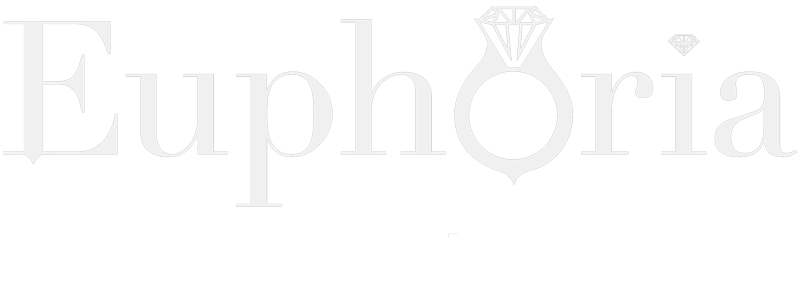FAQs
Firstly, let’s start with what rhodium is.
Rhodium is a chemical element with the symbol RH and atomic number 45.
It’s a very rare, silvery -white, hard metal and a member of the six platinum group metals: platinum, palladium, rhodium, osmium, iridium and ruthenium. Rhodium is the rarest of the platinum group and most valuable precious metal in the world. Rhodium has lower density and a higher melting point than platinum. It is also classified as a noble metal, meaning that it does not react to oxygen easily , it’s a fantastic catalyst , hypoallergenic and resistant to corrosion and oxidation.
For all of the above reasons, rhodium is commonly used in jewellery as a plating alloy to shield a protective coating over your jewellery that increases the durability, resistance to scratching and retains a beautiful shiny lustre. Pendants and earrings hardly ever need to be re-rhodium plated but rings need to be re-rhodium plated often to avoid mishaps as in the photos below.
The customer brought in her jewellery for rhodium plating , she had bought them elsewhere.
The ring shows significant wear, and the rhodium plating has been worn away revealing a yellow colour underneath.


A misconception we came across over the years is that the majority of customers think that 18ct white gold alloy is yellow. Well ,18ct white gold alloy is made of 75% fine gold and 25% alloys. These alloys can be a range of other metals, including silver, copper, and nickel. Each jewellery manufacturing company differs when making their own gold alloy using more or less parts of the other range of metals. Thus, the difference in colour . Using more parts of the other range of metals makes the alloy softer and more prone to mishaps. But of course, there other factors contributing to the deterioration of your rings like occupational and lifestyle wear.
If your 18ct white gold ring looks silvery grey looking underneath when the rhodium plate comes off, we recommend rhodium plating every few months, a good indication is when you see the rhodium plating starting to wear away and looking quite dull.
e.g. To make premium palladium 18ct white gold alloy at Euphoria Jewels we mix pure fine gold and pure palladium, the result is a lovely white gold hue alloy, excellent choice for customers with allergies .
As every ring is unique, we need to inspect your rings before we provide you with a quote.
Generally, rhodium plating starts from $80
We inspect, clean, polish and remove the old rhodium plating before we apply a new thick coating.
As rhodium is a metal, like any other metal used in jewellery, it is susceptible to wear and tear through exposure and friction with other jewellery. It is advisable to rhodium plate your jewellery every 6-12 months depending on the wear of your rings.
Absolutely! We have a full on-site workshop; our services include jewellery repairs, cleaning, polishing ,restoration , setting and replacing stones from antique, vintage pieces to modern and contemporary designs. Our complimentary service includes inspecting your jewellery for any noticeable wear , checking the claws and that all the stones are securely and tightly set.
Over time gold wears down, breaks , dents and thins out due to poor quality manufacturing , as well as occupational and lifestyle wear.
Pure gold is too soft to be made into jewellery on it’s own, so other metals are added to harden the alloy. So, let’s start with what‘s the difference between 9ct and 18ct gold alloy.
9ct gold contains 37.5% pure gold, the remainder is an alloy of various metals, which may include copper, zinc, silver…
18ct gold contains 75% pure gold, the remainder is an alloy of various metals, which may include copper, zinc, silver, palladium… depending on the manufacturer and whether the alloy is yellow, rose or white gold.
In general, 18ct gold is longer lasting and more durable than 9ct gold. Saying that , there are other factors that can influence the durability of a piece of jewellery.
Handmade jewellery is harder and more durable as the metal has been left in the hardest possible form, whether its 18ct or 9ct gold. Compering to commercially made jewellery where the metal has been left in the softest possible form often with tiny microscopic air bubbles/porosity.. in the metal causing metal corrosion over the years.
For some customer’s though, 9ct gold is a great option. Especially if they have inherited a piece of jewellery that they would like to redesign or refurbish . It may also fit with their price bracket.
An 18ct gold piece is more expensive than an equivalent piece in 9ct gold.
So, at the end of the day, it’s entirely up to the customer to make that decision.
Gold discoloration may be caused by poor low grade gold alloy. As we‘ve mentioned above 9ct gold contains 37.5% pure gold, the remainder is an alloy of various metals, which may include copper, zinc, silver … The gold itself does not change but it’s the other components that tarnish over time.
Our services include jewellery remodelling and redesigning; redesigning a piece of jewellery that you no longer wear or remodelling an inherited piece of jewellery into a new creation is a creative and rewarding experience. Our team of experienced jewellers and award-winning designers will help you to redesign your precious jewellery keeping the sentimental value into an exceptional bespoke piece. By recycling your gold and reusing your stones, its a great way to minimise your carbon footprint on Earth, plus it’s the new expected trend!
The cost depends on the design of the piece you choose and how much gold we need.
We provide a free quote consultation, so please feel free to book an appointment to have a chat with one of our experienced jewellers to discuss any queries you may have.
We have a full onsite workshop ; we handmake and custom make bespoke fine jewellery pieces.
We specialise in natural GIA Certified natural diamonds only.
Although, due to recent customer’s requests to lab grown diamonds we can happily source them for you at customer’s request only.
This is still a controversial question, and we will try to answer it to the best of our knowledge and then it’s up to you to make the right decision for you.
There is undoubtedly evidence that global temperature is rising; climate changes, since the pre-industrial period from the 1800s due to human activities, primarily due to fossil fuel burning (like coal , oil, and gas) causing increasing heat – trapping greenhouse gas levels in the Earth’s atmosphere.
Irresponsible diamond mining can certainly have detrimental effects to the environment and in the past the big mining companies were accused of having poor planning and weak environmental regulations. Since then, a lot of things have changed; there is awareness over the climate crisis and a much greater accountability and transparency in the diamond mining industry.
Many natural diamond retailers today will sell ethical diamonds, meaning that the diamonds are sourced from mines without exploiting workers and the environment.
To answer the question a little bit more though , let’s explain how natural diamonds were formed. Natural diamonds have been formed over 3 billion years ago deep within the Earth’s crust under special conditions of intense heat, pressure, and time that cause carbon atoms to crystalise into a diamond.
Lab grown diamonds on the other hand were first created in the 1950s by a team of scientists at the General Electric who were working on developing new material for industrial use and it wasn’t until the 1970s that the technology was advanced enough to produce gem quality lab grown diamonds.
Lab – grown diamonds have the same chemical make -up as their natural counterpart, same optical and physical properties but they have been created in an artificial environment.
To create a lab -grown diamond scientists have to recreate the same natural conditions that are made naturally below the Earth’s mantle in an artificial environment. There are two methods used , which are raising concerns : CVD ( chemical vapour deposition , that relies on temperatures as high as 1500F) and HPHT( replicating the high-pressure, high-temperature conditions above 300F)
Lab-grown diamonds take approximately 6 to 10 weeks to develop in a laboratory and require a huge amount of energy using non-renewable energy sources leading to a significant carbon footprint. Some companies are working to use renewable energy, but more research needs to be done to reduce the environmental impact.
Manufacturers market their lab-grown diamonds as sustainable, and “environmentally friendly” how accurate are they with those definitions?
So far the claims that lab -grown diamonds are ethical and environmentally friendly are based on inaccurate comparisons and not enough documented data (this is still up for debate).
Having questioned our customers over the 40-age bracket, they would admit that they wouldn’t wear a lab grown diamond as “it looks cheap, has no character and, it is not unique”.
On the other hand, Gen Z link towards more purchasing a lab grown diamond as they are really price savvy, and don’t really care about quality and the uniqueness of a naturally created stone which by the way, no two are alike.
Natural diamonds have a romance and a rarity factor because of the way they have been formed and they would always hold their value better than lab grown diamonds.
At the end of the day, it’s entirely up to the customer to decide whether a lab grown, or a natural diamond is the right choice for them.
At Euphoria Jewels we work with the customer’s budget and even though we are passionate about natural diamonds and natural exotic-coloured gemstones we try to accommodate every customer’s request.
We highly recommend professional jewellery cleaning to avoid any kind of damage to your precious jewellery. There are certain types of gemstones that need special cleaning care and throughout the years we have seen plenty examples of customers trying to clean their jewellery at home with unsuccessful results. If you are stuck and would like to clean your rings at home, we recommend hot soapy water, gently scrub with a soft toothbrush and that will usually do the trick!
Absolutely! At Euphoria Jewels , our experienced lapidarist will cut and polish your worn /chipped /scratched gemstone and bring it back to life.
18ct white gold alloy is made of 75% fine gold parts and 25% alloys.
To make premium palladium 18ct white gold alloy at Euphoria Jewels we mix pure fine gold and pure palladium , the result is a lovely white gold hue alloy.
At Euphoria Jewels all our gemstones, diamonds and materials are ethically sourced.
Our Stones are GIA certified and precision cut in Antwerp, Belgium and in Germany.
All our pieces come with a Euphoria Jewels Certificate of Authenticity for Insurance Purposes, information on how to care for your precious jewellery and rare gemstones if applicable and certified valuations. We also provide jewellery valuations for customer’s pieces not made by us from independent valuers.

